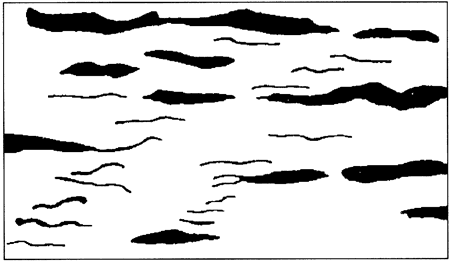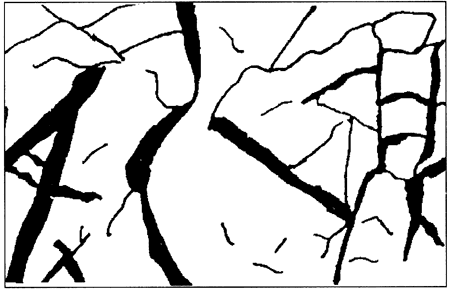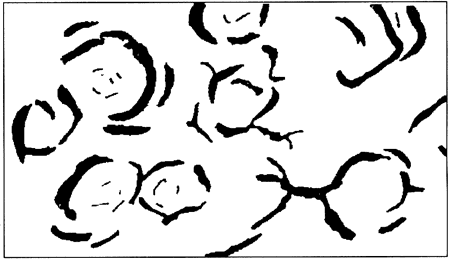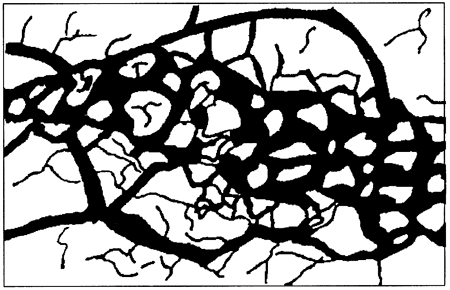Prev Page--Structural Features, Conclusions || Next Page--Appendix F--Lithology
Appendix A: Dunham's (1962) classification of carbonate rocks according to depositional texture
| Depositional texture recognizable | Depositional texture not recognizable (subdivided according to classifications designed to bear on physical texture or diagenesis) |
||||
| Original components not bound together during deposition | Original components were bound together during deposition, as shown by intergrown skeletal matter, lamination contrary to gravity, or sediment-floored cavities that are roofed over by organic or questionably organic matter and are too large to be interstices | ||||
| Contains mud (particles of clay and fine-silt size) | Grain supported | Lacks mud and is grain supported | |||
| Less than 10% grains | More than 10% grains | ||||
| Mudstone* | Wackestone | Packstone | Grainstone | Boundstone | Crystalline carbonate |
|---|---|---|---|---|---|
Dunham (1962) used "lime" as an adjective to differentiate between limestones and dolomites. Because none of the rocks in this study were dolomites, "lime" was deemed superfluous and was not used to modify the types of carbonate rocks.
*A terrigenous mudstone denotes in this publication a shalelike rock that does not display obvious laminae (i.e., not a limestone).
Appendix B: Folk's (1965) code for classification of calcite cement
- I. Mode of formation
- P: Passive precipitation
- D: Dlsplacive precipitation
- N: Neomorphism
- R: Replacement
- II. Shape
- E: Equant, axial ratio <1.5:1
- B: Bladed, axial ratio 1.5:1 to 6:1
- F: Fibrous, axial ratio >6:1
- III. Crystal size
- 7: Extremely coarsely crystalline, >4.0 mm
- 6: Very coarsely crystalline, >1.0 mm
- 5: Coarsely crystalline, >0.25 mm
- 4: Medium crystalline, >0.062 mm
- 3: Finely crystalline, >0.016 mm
- 2: Very finely crystalline, >0.004 mm
- 1: Aphanocrystalline
- IV. Foundation
- O: Overgrowth, in optical continuity with nucleus
- C: Crust, physically oriented by nucleant surface
- S: Spherulitic with no obvious nucleus
Example: PE2 is a passively precipitated, very finely crystalline, equant calcite cement.
Appendix C: Classification of porosity from Choquette and Pray (1970)
Reprinted by permission.
| Basic Porosity Types | |||||
|---|---|---|---|---|---|
| Fabric selective | Not fabric selective | Fabric selective or not | |||
| interparticle (BP) | fracture (FR) | breccia (BR) | |||
| intraparticle (WP) | channel* (CH) | boring (BO) | |||
| intercrystal (BC) | vug* (VUG) | burrow (BU) | |||
| moldic (MO) | cavern* (CV) | shrinkage (SK) | |||
| fenestral (FE) | *cavern applies to human sized or larger pores of channel or vug shapes |
||||
| shelter (SH) | |||||
| growth-framework (GF) | |||||
Modifying terms
| Genetic modifiers | |||
|---|---|---|---|
| Process | Direction or stage | ||
| solution | s | enlarged | x |
| cementation | c | reduced | r |
| internal sediment | i | filled | f |
| Time of formation | ||
|---|---|---|
| Primary | P | |
| pre-depositional | Pp | |
| depositional | Pd | |
| Secondary | S | |
| eogenetic | Se | |
| mesogenetic | Sm | |
| telogenetic | St | |
| Genetic modifiers are combined as follows: Process + Direction + Time |
||
| Examples: | solution - enlarged | sa |
| cement - reduced primary | crP | |
| sediment - filled eogenetic | ifSe | |
| Size* modifiers | ||||
|---|---|---|---|---|
| Classes | mm† | |||
| megapore | mg | large | lmg | 256 |
| 32 | ||||
| small | smg | |||
| 4 | ||||
| mesopore | ms | large | lms | |
| 1/2 | ||||
| small | sms | |||
| 1/16 | ||||
| microspore | mc | |||
| Use size prefixes with basic porosity types: | ||||
| mesovug | msVUG | |||
| small mesomold | smsMO | |||
| microinterparticle | mcBP | |||
| *For regular-shaped pores smaller than cavern size. †measures refer to average pore diameter of a single pore or the range in size of a pore assemblage. For tubular pores use average cross section. For platy pores use width and note shape. |
||||
| Abundance modifiers |
|---|
| percent porosity (15%) or ratio of porosity types (1:2) or ratio and percent (1:2) (15%) |
Construction of Porosity Designation
Any modifying terms are combined with the basic porosity type in sequence given below:
Genetic modifier + size modifier + basic porosity type + abundance
Appendix D: Classification of fractures from Freytet and Plaziat (1982)
Illustration from Goldstein (1986), after Freytet and Plaziat (1982), shows types of fracture patterns that can be found in hand sample or thin section. Reprinted by permission.
1. Horizontal joint planes

2. Skew planes

3. Curved planes

4. Craze planes

Appendix E: Register of localities
| Locality Number |
Location Description |
|---|---|
| P-7 | NWNENW sec. 14, T. 6 S., R. 10 E., Pottawatomie County |
| P-11 | NENENE sec. 26, T. 7 S., R. 11 E., Pottawatomie County |
| J-2 | SWSESE sec. 35, T. 7 S., R. 14 E., Jackson County |
| J-6 | SWSWNW sec. 8, T. 8 S., R. 14 E., Jackson County |
| J-11 | SWSESE sec. 29, T. 8 S., R. 13 E., Jackson County |
| P-13 | SESWSE sec. 11, T. 9 S., R. 12 E., Pottawatomie County |
| J-15 | NENWNE sec. 25, T. 9 S., R. 12 E., Jackson County |
| W-4 | SWSW sec. 27, T. I I S., R. 12 E., Wabaunsee County |
| 1 | NESESE sec. 24, T. 12 S., R. 12 E., Wabaunsee County |
| 2 | SWNENE sec. 21, T. 13 S., R. 12 E., Wabaunsee County |
| 3 | SENENE sec. 19, T. 13 S., R. 13 E., Wabaunsee County |
| 4 | NWNW sec. 23, T. 14 S., R. 12 E., Wabaunsee County |
| 5 | SWNW sec. 4, T. 16 S., R. 12 E., Lyon County |
| 6 | NWNW sec. 35, T. 16 S., R. I I E., Lyon County |
| 7 | NENW sec. 21, T. 17 S., R. I I E., Lyon County |
| 8 | NWSW sec. 14, T. 18 S., R. 10 E., Lyon County |
| 9 | NENE sec. 26, T. 18 S., R. 10 E., Lyon County |
| 10 | SESWNW sec. 26, T. 19 S., R. 7 E., Chase County |
| 11 | SENE sec. 24, T. 19 S., R. 9 E., Chase County |
| 12 | SWSW sec. 33, T. 19 S., R. 10 E., Lyon County |
| 13 | NW sec. 3, T. 20 S., R. 7 E., Chase County |
| 14 | SWSE sec. 4, T. 20 S., R. 10 E., Lyon County |
| 15 | NENW sec. 9, T. 20 S., R. 10 E., Lyon County |
| 16 | SENTW sec. 9, T. 20 S., R. 10 E., Lyon County |
| 17 | SESW sec. 14, T. 20 S., R. 10 E., Lyon County |
| 18 | SE sec. 25, T. 21 S., R. 9 E., Chase County |
| 19 | NNE sec. 21, T. 22 S., R. 10 E., Greenwood County |
| 20 | SWSE sec. 23, T. 23 S., R. 10 E., Greenwood County |
| 21 | NW sec. 5, T. 24 S., R. 10 E., Greenwood County |
| 22 | NENE sec. 36, T. 24 S., R. 9 E., Greenwood County |
| 23 | SW sec. 1, T. 26 S., R. 8 E., Greenwood County |
| 24 | SESE sec. 3 1, T. 26 S., R. 9 E., Greenwood County |
| 25 | NENW sec. 36, T. 27 S., R. 8 E., Greenwood County |
| 26 | SESW sec. 3 1, T. 27 S., R. 9 E., Greenwood County |
| 27 | NESE sec. 4, T. 28 S., R. 9 E., Greenwood County |
| 28 | SWNE sec. 23, T. 28 S., R. 9 E., Elk County |
| 29 | SWSW sec. 3 1, T. 28 S., R. 9 E., Elk County |
| 30 | NW sec. 18, T. 29 S., R. 9 E., Elk County |
| 31 | SW sec. 32, T. 29 S., R. 9 E., Elk County |
| 32 | NW sec. 20, T. 30 S., R. 9 E., Elk County |
| 33 | NWNW sec. 11, T. 31 S., R. 8 E., Elk County |
| 34 | NE sec. 13, T. 31 S., R. 8 E., Elk County |
| 35 | SESE sec. 21, T. 32 S., R. 8 E., Cowley County |
Prev Page--Structural Features, Conclusions || Next Page--Appendix F--Lithology
Kansas Geological Survey, Geology
ISBN: 1-58806-107-8
Placed on web Sept. 8, 2011; originally published 1992.
Comments to webadmin@kgs.ku.edu
The URL for this page is http://www.kgs.ku.edu/Publications/Bulletins/Sub13/06_app.html